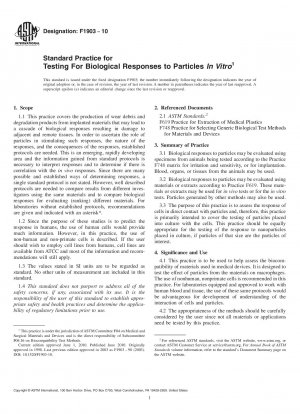ASTM F1903-10
Standard Practice for Testing For Biological Responses to Particles In Vitro
- Standard No.
- ASTM F1903-10
- Release Date
- 2010
- Published By
- American Society for Testing and Materials (ASTM)
- Status
- Replace By
- ASTM F1903-18
- Latest
- ASTM F1903-18
- Scope
This practice is to be used to help assess the biocompatibility of materials used in medical devices. It is designed to test the effect of particles from the materials on macrophages. The use of nonhuman, nonprimate cells is recommended in this practice. For laboratories equipped and approved to work with human blood and tissue, the use of these same protocols would be advantageous for development of understanding of the interaction of cells and particles.
The appropriateness of the methods should be carefully considered by the user since not all materials or applications need be tested by this practice.
Abbreviations:
LPS8212;lipopolysaccharide (endotoxin).
LAL8212;Limulus Amebocyte Lysate.
ATCC8212;American Type Culture Collection.
FCS (FBS)8212;Fetal Calf Serum.
NCS8212;Newborn Calf Serum.
PBS8212;Phosphate Buffered Saline.
HANKS8212;A balanced salt solution.
MMPS8212;Matrix Metallo Proteases.
RPMI 16408212;Specific Growth Medium (Roswell Park Memorial Institute).
HEPES8212;A buffering salt.
1.1 This practice covers the production of wear debris and degradation products from implanted materials that may lead to a cascade of biological responses resulting in damage to adjacent and remote tissues. In order to ascertain the role of particles in stimulating such responses, the nature of the responses, and the consequences of the responses, established protocols are needed. This is an emerging, rapidly developing area and the information gained from standard protocols is necessary to interpret responses and to determine if there is correlation with the in vivo responses. Since there are many possible and established ways of determining responses, a single standard protocol is not stated. However, well described protocols are needed to compare results from different investigators using the same materials and to compare biological responses for evaluating (ranking) different materials. For laboratories without established protocols, recommendations are given and indicated with an asterisk*.
1.2 Since the purpose of these studies is to predict the response in humans, the use of human cells would provide much information. However, in this practice, the use of non-human and non-primate cells is described. If the user should wish to employ cell lines from humans, cell lines are available from ATCC and most of the information and recommendations will still apply.
1.3 The values stated in SI units are to be regarded as standard. No other units of measurement are included in this standard.
1.4 This standard does not purport to address all of the safety concerns, if any, associated with its use. It is the responsibility of the user of this standard to establish appropriate safety and health practices and determine the applicability of regulatory limitations prior to use.
ASTM F1903-10 Referenced Document
- ASTM F619 Standard Practice for Extraction of Medical Plastics
- ASTM F748 Standard Practice for Selecting Generic Biological Test Methods for Materials and Devices
ASTM F1903-10 history
- 2018 ASTM F1903-18 Standard Practice for Testing for Cellular Responses to Particles
in vitro - 2010 ASTM F1903-10 Standard Practice for Testing For Biological Responses to Particles In Vitro
- 1998 ASTM F1903-98(2003) Standard Practice for Testing for Biological Responses to Particles In Vitro
- 1998 ASTM F1903-98 Standard Practice for Testing for Biological Responses to Particles In Vitro
